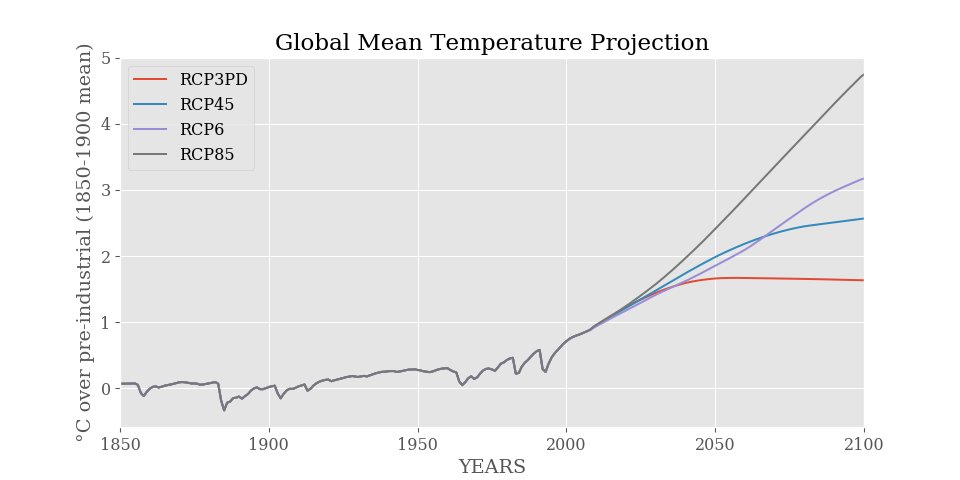 |
 |
|---|---|
 |
 |
 |
 |
Pymagicc is a thin Python wrapper around the reduced complexity climate model MAGICC6. It wraps the CC-BY-NC-SA licensed MAGICC6 binary.
Pymagicc makes the MAGICC model easily installable and usable from Python and can for example be used in the analysis of mitigation scenarios, in integrated assessment models, complex climate model emulation, and uncertainty analyses.
To explore Pymagicc an example notebook and small demo app are available thanks to the Binder project.
See http://www.magicc.org/ for further information about the MAGICC model.
import pymagicc
from pymagicc import scenarios
import matplotlib.pyplot as plt
for name, scen in scenarios.items():
results, params = pymagicc.run(scen, return_config=True)
temp = (results["SURFACE_TEMP"].GLOBAL.loc[1850:] -
results["SURFACE_TEMP"].GLOBAL.loc[1850:1900].mean())
temp.plot(label=name)
plt.legend()
plt.title("Global Mean Temperature Projection")
plt.ylabel(u"°C over pre-industrial (1850-1900 mean)")
# Run `plt.show()` to display the plot when running this example
# interactively or add `%matplotlib inline` on top when in a Jupyter Notebook.pip install pymagicc
On Linux and OS X the original compiled Windows binary available on http://www.magicc.org/ and included in Pymagicc can run using Wine.
On modern 64-bit systems one needs to use the 32-bit version of Wine
sudo dpkg --add-architecture i386
sudo apt-get install wine32
On 32-bit systems Debian/Ubuntu-based systems wine can be installed with
sudo apt-get install wine
On OS X wine is available in the Homebrew package manager:
brew install wine
Note that after the first install the first run of Pymagicc might be slow due
to setting up of the wine configuration and be accompanied by pop-ups or
debug output.
To run an example session using Jupyter Notebook and Python 3 you can run the
following commands to create a virtual environment venv and install an
editable version for local development:
git clone https://github.com/openclimatedata/pymagicc.git
cd pymagicc
make venv
./venv/bin/pip install -e .
./venv/bin/jupyter-notebook notebooks/Example.ipynb
For local development run
make venv
./venv/bin/pip install --editable .
inside of a clone or download of the Pymagicc repository to install dependencies and an editable version of Pymagicc.
To run the tests run
./venv/bin/pytest tests --verbose
To get a test coverage report, run
./venv/bin/pytest --cov
from pymagicc import rcp3pd
rcp3pd["WORLD"].head()from pymagicc import read_scen_file
scenario = read_scen_file("PATHWAY.SCEN")Pymagicc uses Pandas DataFrames to represent scenarios. Dictionaries are used for scenarios with multiple regions.
import pandas as pd
scenario = pd.DataFrame({
"FossilCO2": [8, 10, 9],
"OtherCO2": [1.2, 1.1, 1.2],
"CH4": [300, 250, 200]},
index=[2010, 2020, 2030]
)output = pymagicc.run(scenario)
# Projected temperature adjusted to pre-industrial mean
temp = (output["SURFACE_TEMP"].GLOBAL -
output["SURFACE_TEMP"].loc[1850:2100].GLOBAL.mean())The _magiccpath and _magiccbinary can be changed to point to different MAGICC
development versions.
pymagicc._magiccpath = "/home/robert/openclimatedata/pymagicc/MAGICC_test/"
pymagicc._magiccbinary = "./magicc"read_scen_file(scen_file)Reads a MAGICC .SCEN file and returns a a dictionary of DataFrames or, for World Only scenarios, a DataFrame.
run(scenario, output_dir=None, return_config=False, **kwargs)Return output data and (optionally) used parameters from a MAGICC run.
output_dir:
Path for MAGICC data and binary, if None a temp file which will be
deleted automatically.
return_config:
Additionaly return the full list of parameters used. default False
kwargs:
Parameters overwriting default parameters.
output: dict
Dictionary with all data from MAGICC output files.
parameters: dict
Parameters used in the MAGICC run. Only returned when
``return_config`` is set to True
write_scen_file(scenario, path_or_buf=None, description1=None, description2=None, comment=None)Write a Dictionary of DataFrames or DataFrame to a MAGICC .SCEN-file.
scenario: DataFrame or Dict of DataFrames
DataFrame (for scenarios with only the World region) or Dictionary with
regions.
path_or_buf:
Pathname or file-like object to write the scenario to.
description_1:
Optional description line.
description_2:
Optional second description line.
comment:
Optional comment at end of scenario file.
Please report issues or discuss feature requests on Pymagicc's issue tracker.
You can also contact the pymagicc authors via email
robert.gieseke@pik-potsdam.de.
The compiled MAGICC binary by Tom Wigley, Sarah Raper, and Malte Meinshausen included in this package is licensed under a Creative Commons Attribution-NonCommercial-ShareAlike 3.0 Unported License.
The pymagicc wrapper is free software under the GNU Affero General Public
License v3, see LICENSE.
If you make any use of MAGICC, please cite:
M. Meinshausen, S. C. B. Raper and T. M. L. Wigley (2011). "Emulating coupled atmosphere-ocean and carbon cycle models with a simpler model, MAGICC6: Part I "Model Description and Calibration." Atmospheric Chemistry and Physics 11: 1417-1456. doi:10.5194/acp-11-1417-2011
See also the MAGICC website and Wiki for further information.
